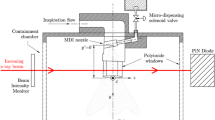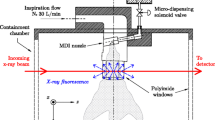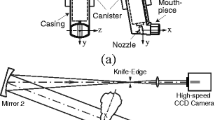ABSTRACT
Purpose
Sprays from pressurised metered-dose inhalers are produced by a transient discharge of a multiphase mixture. Small length and short time scales have made the investigation of the governing processes difficult. Consequently, a deep understanding of the physical processes that govern atomisation and drug particle formation has been elusive.
Methods
X-ray phase contrast imaging and quantitative radiography were used to reveal the internal flow structure and measure the time-variant nozzle exit mass density of 50 µL metered sprays of HFA134a, with and without ethanol cosolvent. Internal flow patterns were imaged at a magnification of 194 pixels/mm and 7759 frames per second with 150 ps temporal resolution. Spray projected mass was measured with temporal resolution of 1 ms and spatial resolution 6 µm × 5 µm.
Results
The flow upstream of the nozzle comprised large volumes of vapour at all times throughout the injection. The inclusion of ethanol prevented bubble coalescence, altering the internal flow structure and discharge. Radiography measurements confirmed that the nozzle exit area is dominantly occupied by vapour, with a peak liquid volume fraction of 13%.
Conclusion
Vapour generation in pMDIs occurs upstream of the sump, and the dominant volume component in the nozzle exit orifice is vapour at all times in the injection. The flow in ethanol-containing pMDIs has a bubbly structure resulting in a comparatively stable discharge, whereas the binary structure of propellant-only flows results in unsteady discharge and the production of unrespirable liquid masses.










Similar content being viewed by others
Abbreviations
- APS:
-
Advanced Photon Source
- FWHM:
-
Full-width at half-maximum
- HFA:
-
Hydrofluoroalkane
- HFM:
-
Homogeneous frozen model
- pMDI:
-
Pressurised metered-dose inhaler
- TIM:
-
Transverse integrated mass
REFERENCES
Andreoli-Ball L, Patterson D, Costas M, Cáceres-Alonso M. Heat capacity and corresponding states in alkan-1-ol–n-alkane systems. J Chem Soc, Faraday Trans 1. 1988;84(11):3991–4012.
Azzopardi B. Drops in annular two-phase flow. Int J Multiphase Flow. 1997;23:1–53.
Bean H, Buckingham E, Murphy P (1929) Discharge coefficients of square-edged orifices for measuring the flow of air. US National Bureau of Standards Research Paper 49
Bendat JS, Piersol AG. Random data: analysis and measurement procedures. 2nd ed. New York: Wiley; 1986.
Berger M, Hubbell J, Seltzer S, Chang J, Coursey J, Sukumar R, et al. Xcom: photon cross sections database. NIST Standard Ref Database. 1998;8:3587–97.
Chen Y, Young PM, Murphy S, Fletcher DF, Long E, Lewis D, Church T, Traini D. High-speed laser image analysis of plume angles for pressurised metered dose inhalers: The effect of nozzle geometry. AAPS PharmSciTech 2016. pp 1–8
Chesters A, Hofman G. Bubble coalescence in pure liquids. In: Mechanics and Physics of Bubbles in Liquids, Springer, 1982 pp 353–361.
Chigier N. Optical imaging of sprays. Prog Energy Combust Sci. 1991;17(3):211–62.
Clark AR. Metered atomisation for respiratory drug delivery. PhD thesis, Loughborough University of Technology. 1991.
Corradini ML (1997) Fundamentals of multiphase flow. URL http://wins.engr.wisc.edu/teaching/mpfBook/main.html.
Duke D, Swantek A, Tilocco Z, Kastengren A, Fezzaa K, Neroorkar K, Moulai M, Powell C, Schmidt D. X-ray imaging of cavitation in diesel injectors. Tech. rep., SAE Technical Paper. 2014.
Duke DJ, Kastengren AL, Mason-Smith N, Chen Y, Young PM, Traini D, Lewis D, Edgington-Mitchell D, Honnery D. Temporally and spatially resolved x-ray fluorescence measurements of in-situ drug concentration in metered-dose inhaler sprays. Pharm Res. 2016;33(4):816–25.
Dunbar C. An experimental and theoretical investigation of the spray issued from a pressurised metered-dose inhaler. PhD thesis, University of Manchester, Manchester, United Kingdom. 1996.
Dunbar C, Miller J. Theoretical investigation of the spray from a pressurized metered-dose inhaler. AtomizationSprays. 1997;7 (4).
Gavtash B, Myatt B, O’Shea H, Mason F, Church T, Versteeg H, Hargrave G, Brambilla G. Saturated vapour pressure (SVP) measurement of ethanol/HFA binary mixtures. In: Drug Delivery to the Lungs 26. 2015.
Gureyev T, Mayo S, Myers D, Nesterets Y, Paganin D, Pogany A, et al. Refracting Röntgen’s rays: propagation-based x-ray phase contrast for biomedical imaging. J Appl Phys. 2009;105(10):102,005.
Hengstebeck RJ. Distillation: principles and design procedures. Reinhold Pub. Corp. 1961.
Hewitt G, Hall-Taylor N. Annular two-phase flow. Pergamon Press. 1970.
Huang NE, Shen Z, Long SR, Wu MC, Shih HH, Zheng Q, et al. Liu HH (1998) The empirical mode decomposition and the Hilbert spectrum for nonlinear and non-stationary time series analysis. Proc R Soc Lond A: Math Phys Eng Sci. 1971;454:903–95.
Ivey JW, Vehring R, Finlay WH. Understanding pressurized metered dose inhaler performance. Expert Opin Drug Deliv. 2015;12(6):901–16.
Jähne B. Digital image processing, 6th ed. Springer. 2005.
Ju D, Shrimpton J, Hearn A. The effect of reduction of propellant mass fraction on the injection profile of metered dose inhalers. Int J Pharm. 2010;391(1):221–9.
Kastengren A, Powell C. Spray density measurements using x-ray radiography. Proc Inst Mech Eng, D: Journal of Automob Eng. 2007;221(6):653–62.
Kastengren A, Powell CF. Synchrotron X-ray techniques for fluid dynamics. Exp Fluids. 2014;55(3):1–15.
Kastengren A, Powell CF, Liu Z, Wang J. Time resolved, three dimensional mass distribution of diesel sprays measured with x-ray radiography. Tech. rep., SAE Technical Paper. 2009.
Kastengren A, Powell CF, Arms D, Dufresne EM, Gibson H, Wang J. The 7BM beamline at the APS: a facility for time-resolved fluid dynamics measurements. J Synchrotron Radiat. 2012;19(4):654–7.
Kastengren AL, Tilocco FZ, Duke DJ, Powell CF, Zhang X, Moon S. Time-resolved X-ray radiography of sprays from engine combustion network spray A diesel injectors. Atomization Sprays. 2014;24 (3)
Kraynik AM. Foam flows. Annu Rev Fluid Mech. 1988;20(1):325–57.
Lemmon E, McLinden M, Friend D. Thermophysical properties of fluid systems. NIST Chemistry Webbook, NIST Standard Reference Database 69. 2005.
Linne M. Analysis of X-ray phase contrast imaging in atomizing sprays. Exp Fluids. 2012;52(5):1201–18.
Mason-Smith N, Duke D, Fedrizzi M, Soria J, Edgington-Mitchell D, Honnery D. Back-illumination imaging of pressurised metered-dose inhaler sprays. In: Australian Conference on Laser Diagnostics in Fluid Mechanics and Combustion (Damon Honnery and Daniel Edgington-Mitchell 09 December 2015 to 11 December 2015), Monash University Publishing, 2015. pp 45–50
Mason-Smith N, Edgington-Mitchell D, Honnery D, Duke D, Soria J. Pressurised metered-dose inhaler spray structure. In: Proceedings of Turbulence and Shear Flow Phenomena 9, Melbourne, Australia. 2015.
Mason-Smith N, Duke DJ, Kastengren AL, Stewart PJ, Traini D, Young PM, et al. Insights into spray development from metered-dose inhalers through quantitative x-ray radiography. Pharm Res. 2016;33(5):1249–58.
Moon S, Gao Y, Park S, Wang J, Kurimoto N, Nishijima Y. Effect of the number and position of nozzle holes on in- and near-nozzle dynamic characteristics of diesel injection. Fuel. 2015;150:112–22.
Mullinger P, Chigier N. Design and performance of internal mixing multijet twin fluid atomizers. J Inst Fuel. 1974;47(393):251–61.
Myatt B, Newton R, Lewis D, Church T, Brambilla G, Hargrave G, Versteeg H, Gavtash B, Long E. PDA and high speed image analysis of HFA/ethanol pMDI aerosols: New findings. Drug Deliv Lungs 2015;26.
Nurick W, Ohanian T, Talley D, Strakey P. Impact of orifice length/diameter ratio on 90 deg sharp-edge orifice flow with manifold passage cross flow. J Fluids Eng. 2009;131(8):081,103.
Park BS, Lee SY. An experimental investigation of the flash atomization mechanism. Atomization Sprays. 1994;4 (2)
Powell CF, Yue Y, Poola R, Wang J. Time-resolved measurements of supersonic fuel sprays using synchrotron x-rays. J Synchrotron Radiat. 2000;7(6):356–60.
San Lee J, Weon BM, Je JH. X-ray phase-contrast imaging of dynamics of complex fluids. J Phys D Appl Phys. 2013;46(49):494,006.
Sanada T, Sato A, Shirota M, Watanabe M. Motion and coalescence of a pair of bubbles rising side by side. Chem Eng Sci. 2009;64(11):2659–71.
Schmidt DP, Corradini M. The internal flow of diesel fuel injector nozzles: a review. Int J Engine Res. 2001;2(1):1–22.
Shemirani FM, Church TK, Lewis DA, Finlay WH, Vehring R. Onset of flash atomization in a propellant microjet. J Fluids Eng. 2015;137(9):091,101.
Sher E, Bar-Kohany T, Rashkovan A. Flash-boiling atomization. Prog Energy Combust Sci. 2008;34(4):417–39.
Smyth H, Mejia-Millan E, Hickey A. The effect of ethanol on solvency, vapor pressure, and emitted droplet size of solution metered dose inhalers containing HFA 134a. Respir Drug Deliv. 2002;8:2.
Smyth H, Hickey A, Brace G, Barbour T, Gallion J, Grove J. Spray pattern analysis for metered dose inhalers I: orifice size, particle size, and droplet motion correlations. Drug Dev Ind Pharm. 2006;32(9):1033–41.
Takagi S, Matsumoto Y. Surfactant effects on bubble motion and bubbly flows. Annu Rev Fluid Mech. 2011;43:615–36.
Wang Y, Liu X, Im KS, Lee WK, Wang J, Fezzaa K, et al. Ultrafast x-ray study of dense-liquid-jet flow dynamics using structure-tracking velocimetry. Nat Phys. 2008;4(4):305–9.
Yang YM, Maa JR. Bubble coalescence in dilute surfactant solutions. J Colloid Interface Sci. 1984;98(1):120–5.
Zhu B, Traini D, Chan HK, Young PM. The effect of ethanol on the formation and physico-chemical properties of particles generated from budesonide solution-based pressurized metered-dose inhalers. Drug Dev Ind Pharm. 2013;39(11):1625–37.
ACKNOWLEDGMENTS AND DISCLOSURES
The authors gratefully acknowledge the support given to the project by the Australian Research Council. The authors wish to thank Dr. Chris Powell and Dr. Katarzyna Matusik, Energy Systems Division, Argonne National Laboratory, Dr. Jin Wang and Dr. Don Walko, X-Ray Science Division, Argonne National Laboratory, and Mr. James Harkess, Monash University. This research was performed at the 7-ID and 7-BM beamlines of the Advanced Photon Source at Argonne National Laboratory. Use of the APS is supported by the U.S. Department of Energy (DOE) under Contract No. DE-AC02-06CH11357. The U.S. Government retains for itself, and others acting on its behalf, a paid-up nonexclusive, irrevocable worldwide license in said article to reproduce, prepare derivative works, distribute copies to the public, and perform publicly and display publicly, by or on behalf of the Government.
Author information
Authors and Affiliations
Corresponding author
Electronic supplementary material
Below is the link to the electronic supplementary material.
(MP4 160669 kb)
Rights and permissions
About this article
Cite this article
Mason-Smith, N., Duke, D.J., Kastengren, A.L. et al. Revealing pMDI Spray Initial Conditions: Flashing, Atomisation and the Effect of Ethanol. Pharm Res 34, 718–729 (2017). https://doi.org/10.1007/s11095-017-2098-2
Received:
Accepted:
Published:
Issue Date:
DOI: https://doi.org/10.1007/s11095-017-2098-2




